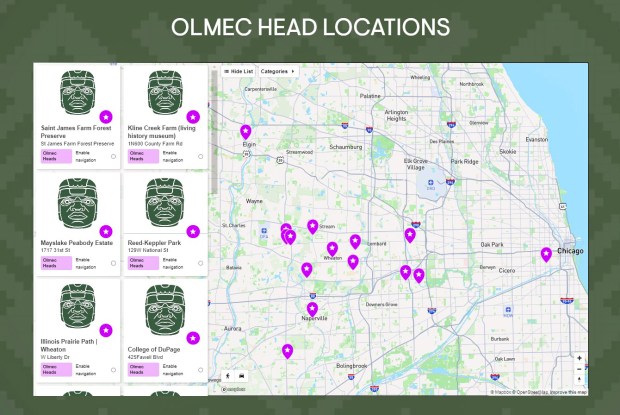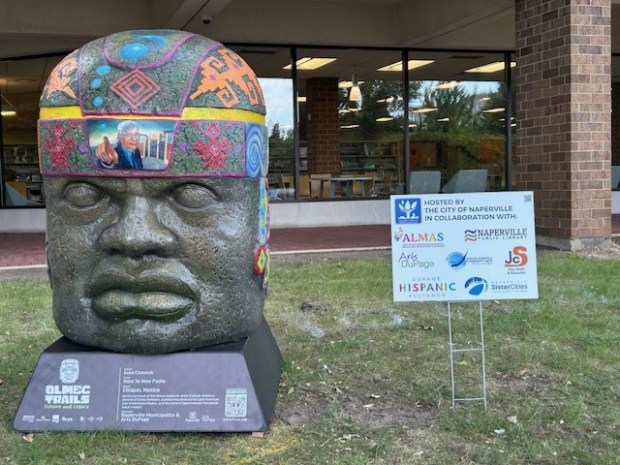This summer and fall, Naperville is shining a spotlight on Latin American culture.
And at the crux of celebration is a pair of hand-painted colossal heads.
Over the next few months, Naperville will be helping host “Olmec Trails: Culture and Legacy,” a countywide art exhibit devised to pay tribute to the indigenous roots of Mexican culture and signify the importance of public art.
The outdoor exhibit consists of 33 unique, large-scale sculptures inspired by colossal stone heads crafted by the early Meso-American Olmec civilization more than 3,000 years ago.
The Olmec heads originated in the southern part of Veracruz, Mexico, and date back to between 1400 BCE to 400 BCE. They are regarded as the most famous artifacts left behind by the Olmecs, considered a founding culture of Meso-America.
The Olmec Trails exhibit is bringing localized renditions of the sculptures to locations all across DuPage County — including Naperville. Now through October, two Olmec Trails sculptures will be on display outside of Naperville Public Library’s Nichols and 95th Street branches.
The exhibit’s other 31 sculptures have been installed on the walking paths of College of DuPage, St. James Farm in Warrenville, Kline Creek Farm in West Chicago and Mayslake Peabody Estate in Oak Brook, among a few other spots.
The Mexican Cultural Center DuPage — in collaboration with Meztli Mexico, the College of Dupage Public Art Project and DuPage Convention & Visitors Bureau — is behind the project.

Dawn Portner, Naperville’s special events coordinator, said the city heard about the venture through District 3 DuPage County Board member Lucy Chang Evans, a Naperville resident who connected with a city official back in February and flagged it as something in which the city could participate. After some research, staff agreed.
All the city had to do was find enough funding to make it happen. Statues came at a cost of $5,000 apiece, Portner said. For the two the city wanted to host, that’s $10,000.
But the project “was just very enticing to us,” Portner said, “and something we didn’t want to miss out on.”
To finance Naperville’s involvement, Arts DuPage and the DuPage Foundation kicked in a $2,500 grant, the Naperville Public Library supplied another $1,000 and the remaining $6,500 came through the city’s Special Events and Community Arts Commission.
Sculptures were installed last Monday.
They were painted at the College of DuPage, in Mexico and in West Chicago through the help of 33 different artists from across North America. Each head is one-of-a-kind.
The sculptures at Nichols and 95th Street libraries in Naperville were created by Juan Aguilar Santis Chawuk and Flavio Lopez Lopez, respectively.

Chawuk’s work is entitled, “Hosts to New Paths,” according to a directory of the sculptures and their artists online. His head, like the others in the Olmec Trails exhibit, is brightly colored and intricately designed. But at the center is a small painting depicting the founder and former president of Chicago’s National Museum of Mexican Art, Carlos Tortolero.
In a written preview of his piece, Chawuk, whose hometown is in the southern Mexican state of Chiapas, describes, “It is like a vision that the artists who made the Olmec heads had, they know about the permanence of actions and those architects know about the great historical potential of a visionary: the master Carlos Tortolero.”
Lopez’s piece is entitled, “Echoes of Identity.” According to Lopez, also of Chiapas, his sculpture depicts the cultural diversity of his home state.
“The city is incredibly grateful to partner with … wonderful organizations to highlight Latin American heritage in the Naperville community,” Naperville City Manager Doug Krieger said in a press release.
The sculptures alone are just the start. To complement the Olmec heads, the city is working with Naperville-based nonprofit Alliance of Latinos Motivating Action in the Suburbs (ALMAS), the DuPage Hispanic Alliance, Naperville Public Library and the Naperville Sister Cities Foundation to hold programming centered around Mexican culture while the exhibit runs.
Although plans have not yet been finalized, Portner said programming could include library events as well as guest speakers to discuss Mexican culture and the Olmec Trails project in particular. The city will also be holding a ribbon-cutting ceremony for its sculptures from 5 to 6 p.m. Wednesday, July 24, at Nichols Library.
Diana Torres Hawken, founding member of ALMAS, said “we’ve got some great ideas.” Though she said details can’t be shared quite yet, programming will be “highly educational, culturally relevant, authentic and responsive to the culture we’re trying to share about.”
Speaking to ALMAS’ involvement in helping Naperville promote Olmec Trails, Torres Hawken said, “I think as an organization that’s trying to promote and celebrate Latino cultures, this has been such a great opportunity to do that.”
An interactive map of where the Olmec heads can be found around DuPage County can be accessed at www.theccma.org/olmectrails.
Naperville Sun freelance reporter Annie Alleman and The Associated Press contributed.



